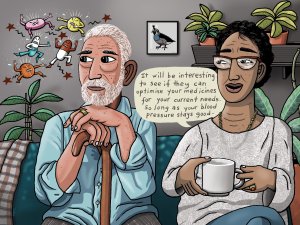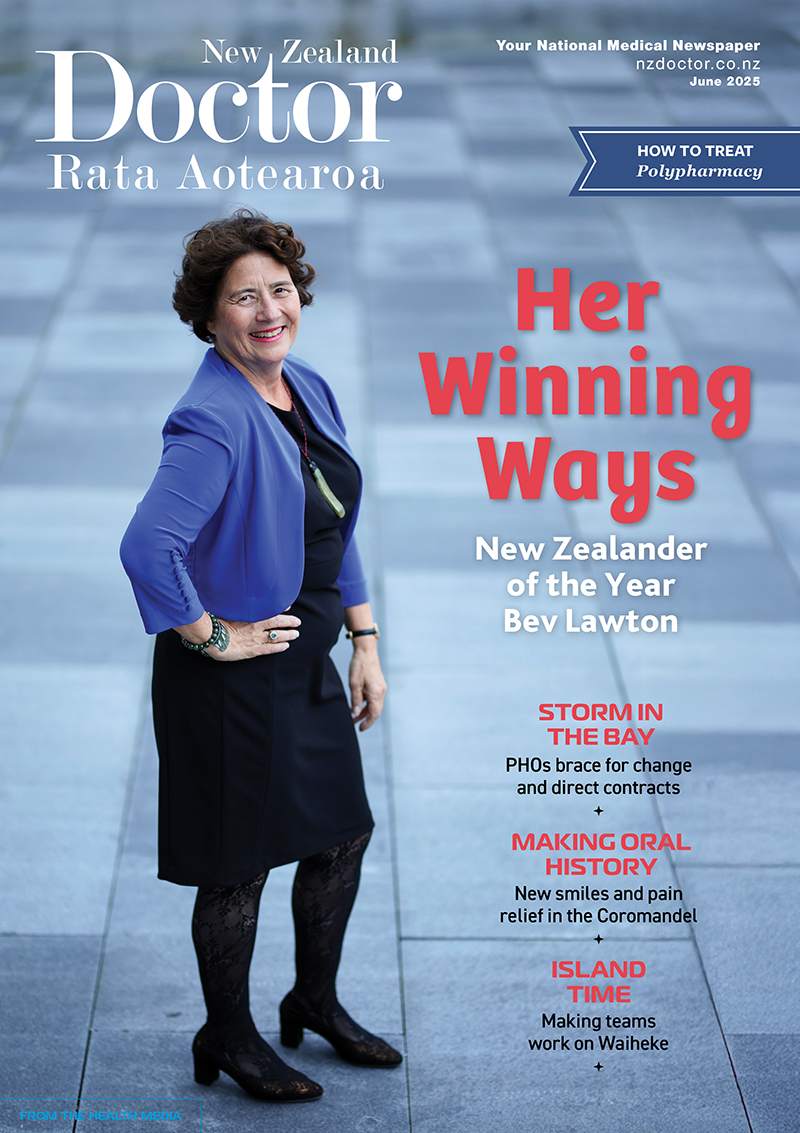For older people and frail people, the long-term benefit of medicines reduces and the potential for harm from adverse effects increases. When the benefit–risk balance changes in this way, medicine review and optimisation are important to simplify the therapeutic regimen, reduce inappropriate medicines and minimise risks. In this article, pharmacist prescriber Linda Bryant uses two case studies to illustrate important considerations during medicine reviews
New market research reveals sight is New Zealand’s most valued sense
New market research reveals sight is New Zealand’s most valued sense

New Zealanders overwhelmingly value their vision above all other senses according to recent market research, with participants saying they’d be willing to lose 5.6 years of perfect health, rather than live a decade without sight[1].
Nearly nine in 10 New Zealanders (89 per cent) say sight is their most important sense, and more than three quarters (77 per cent) would prefer a shorter life with all their senses intact over a longer life without vision. This preference is especially strong among those aged 70–80, with more than eight out of 10 (85 per cent) saying they’d rather live a shorter life than lose their vision.
The new market research by Roche also found that nine in 10 (90 per cent) New Zealanders understood the importance of regular eye examinations, but just four in 10 (40 per cent) get their eyes checked regularly. Factors such as age and income contribute to the likelihood of getting a regular eye examination, while Māori, Pasifika, and people living in some parts of the country, including Auckland and parts of the lower North Island are much less likely to do so.
While most New Zealanders understand the importance of their vision, public awareness of specific eye conditions, their symptoms, and how to prevent vision loss remains low.
Regular eye examinations to detect issues are often neglected, and investment in eye health services remains inadequate – all contributing to New Zealanders suffering preventable, irreversible vision loss. Timely access to eye healthcare prevents more than 80 per cent of permanent visual impairment and blindness, which may otherwise, without timely treatment, become irreversible[2].
“This gap between what we say we value and what we do to protect our vision is a serious public health concern,” says Dr Francesc March, a leading clinical ophthalmologist, who is presenting this week at the Royal Australian and New Zealand College of Ophthalmologists (RANZCO) Annual Scientific Meeting in Rotorua.
“Vision loss can have a profound effect on a person’s independence and quality of life – but its impact extends beyond the individual, affecting carers, family, and the wider community.”
Despite the high value placed on vision, eye health remains under-prioritised in New Zealand. Access to care and treatment is increasingly challenging, with significant capacity issues in eye health services. In 2023, the average wait time for a first ophthalmology appointment reached 88 days - a 27% increase over five years[3].
“There are significant hurdles to receiving optimal eye care, from limited access to specialists, to the emotional and physical distress of certain treatments. New Zealanders need more sustainable, equitable solutions that prioritise early detection and ensure timely, effective treatment to preserve their most important sense - their sight,” says Dr March.
The leading cause of blindness in New Zealand, accounting for around half of all cases, is age-related macular degeneration (AMD). AMD is a progressive eye disease that affects the macula - the central part of the retina responsible for sharp, detailed vision. It can severely impact a person’s ability to read, drive, and recognise faces. Vision loss can have serious health consequences, increasing the risk of falls, fractures, depression, loss of independence and a low quality of life.
AMD's early symptoms, which can often be mistaken for normal signs of ageing, include blurred vision, difficulty seeing at a distance, and the appearance of distortion. The most aggressive form of AMD, known as wet AMD, can lead to functional blindness within just two years, yet it is often preventable with early detection and access to effective and consistent treatment [4],[5],[6].
The current treatment for wet AMD in New Zealand is frequent injections into the eye, in some cases as often as every four weeks (up to 12 injections per year), which is demanding and challenging to maintain. Availability of regular clinics, logistical challenges, travel costs, fear of the procedure, and long wait times in an already stretched health system, often lead to missed or delayed appointments. The tragic consequence of this is preventable vision loss.
New long-acting treatments for wet AMD have the potential to reduce the frequency of injections by half, with injections every three to four months (up to four injections per year) [7],[8]. This helps to ease pressure on the health system, reduce waiting times, and allow resources to be reallocated toward earlier diagnosis and more equitable access to care.
Dr Kerryn Symons, Roche New Zealand Country Medical Director, says “Our market research highlights just how important vision is to New Zealanders – and the very real fear that comes with the possibility of losing it. By delivering innovation in treatment, we have the potential to transform how eye conditions like AMD are managed, easing access challenges and reducing the treatment burden, so that fewer New Zealanders are faced with the reality of losing their sight.”
“Roche is committed to supporting and driving innovation in eye health and believes investment in new treatments can help reduce vision loss in the community, while also delivering benefits to New Zealand’s health system and economy,” says Dr Symons.
For New Zealanders over the age of 50, it’s important to monitor for any changes in vision and speak to a healthcare professional at the first sign of symptoms.
- Kantar. (2025). Public perceptions of sight in New Zealand: April 2025 research report. Roche New Zealand
- RANZCO (2023). New Zealand Vision 2030: A strategy to eliminate avoidable blindness and vision loss in Aotearoa New Zealand. The Royal Australian and New Zealand College of Ophthalmologists. Retrieved from https://ranzco.edu/wp-content/uploads/2023/05/NZ-Vision-2030_FINAL.pdf
- Hong, C. Y., Merriman, M., Wilson, G., & Hong, S. C. (2024). Update and projections for New Zealand’s ophthalmology workforce. New Zealand Medical Journal, 137(1599).
- Macular Degeneration New Zealand. Key Facts. [Internet: cited April 2025]. Available at: https://www.mdnz.org.nz/key-facts.
- Sacconi R, Corbelli E, Querques L, Bandello F, Querques G. A Review of Current and Future Management of Geographic Atrophy. Ophthalmology and Therapy. 2017; 6:69-77.
- NHS Choices. Macular Degeneration. [Internet; cited November 2021] Available from: http://www.nhs.uk/Conditions/Macular-degeneration/Pages/Introduction.aspx.
- Heier JS, et al. Efficacy, durability, and safety of intravitreal faricimab up to every 16 weeks for neovascular macular degeneration (nAMD) (TENAYA and LUCERNE): two randomised, double-masked, Phase III, non-inferiority trials. The Lancet. 2022; 399:729-40.
- Khanani AM et al. Two-Year Results from the Phase 3 Neovascular Age Related Macular Degeneration Trials of Faricimab with Treat-and-Extend Dosing in Year 2. Am Acad Ophthal 2024 131:914-26




![New Zealand Doctor Rata Aotearoa editor Barbara Fountain, RNZCGP president elect and Tauranga-based specialist GP Luke Bradford, Ministry of Health clinical chief advisor rural health Helen MacGregor, and Health New Zealand Te Whatu Ora clinical director primary and community care Sarah Clarke [Image: NZD]](/sites/default/files/styles/thumbnail_cropped_100/public/2025-05/1.%20Barbara%20Fountain%2C%20Luke%20Bradford%2C%20Helen%20MacGregor%20and%20Sarah%20Clarke.jpg?itok=091NETXI)
![Ngāti Porou Oranga specialist GP Elina Pekansaari and Te Nikau Hospital specialist in general practice and rural hospital medicine David Short [Image: NZD]](/sites/default/files/styles/thumbnail_cropped_100/public/2025-05/2.%20Elina%20Pekansaari%20and%20David%20Short.jpg?itok=h5XfSBVM)
![Locum specialist GP Margriet Dijkstra and OmniHealth regional operations manager (southern) Patricia Morais-Ross [Image: NZD]](/sites/default/files/styles/thumbnail_cropped_100/public/2025-05/3.%20Margriet%20Dijkstra%20and%20Patricia%20Morais-Ross.jpg?itok=jkrtRfJC)
![Golden Bay dairy farmer and dairy industry health and safety doctoral student Deborah Rhodes, and Golden Bay Community Health specialist GP Rachael Cowie [Image: NZD]](/sites/default/files/styles/thumbnail_cropped_100/public/2025-05/4.%20Deborah%20Rhodes%20and%20Rachael%20Cowie.jpg?itok=oM0_GcJc)
![Hauora Taiwhenua clinical director rural health Jeremy Webber, Australian College of Rural and Remote Medicine president Rod Martin and Observa Care director of business operations Deborah Martin, the wife of Dr Martin [Image: NZD]](/sites/default/files/styles/thumbnail_cropped_100/public/2025-05/5.%20Jeremy%20Webber%2C%20Rod%20Martin%20and%20Deborah%20Martin%2C%20the%20wife%20of%20Dr%20Martin.jpg?itok=P_aGmX_H)
![Spark Health chief executive John Macaskill-Smith and client director Bryan Bunz [Image: NZD]](/sites/default/files/styles/thumbnail_cropped_100/public/2025-05/6.%20John%20Macaskill-Smith%20and%20Bryan%20Bunz.jpg?itok=5yJvVZ0I)
![Associate dean (rural) Kyle Eggleton, third-year medical student Roselle Winter, and second-year pharmacy student Alina Khanal, all from the University of Auckland [Image: NZD]](/sites/default/files/styles/thumbnail_cropped_100/public/2025-05/7.%20Kyle%20Eggleton%2C%20Roselle%20Winter%20and%20Alina%20Khanal.jpg?itok=RQLd3TEs)
![Health New Zealand Te Whatu Ora clinical editor and specialist in general practice and rural hospital medicine Anu Shinnamon, and Whakarongorau chief clinical officer Ruth Large [Image: NZD]](/sites/default/files/styles/thumbnail_cropped_100/public/2025-05/8.%20Anu%20Shinnamon%20and%20Ruth%20Large.jpg?itok=i5TMswY9)
![Te Kahu Hauora Practice specialist GP Jane Laver and Ngāti Kahungunu ki Tāmaki-nui-a-Rua chief operations manager Tania Chamberlain [Image: NZD]](/sites/default/files/styles/thumbnail_cropped_100/public/2025-05/9.%20Jane%20Laver%20and%20Tania%20Chamberlain.jpg?itok=jtMklaCZ)